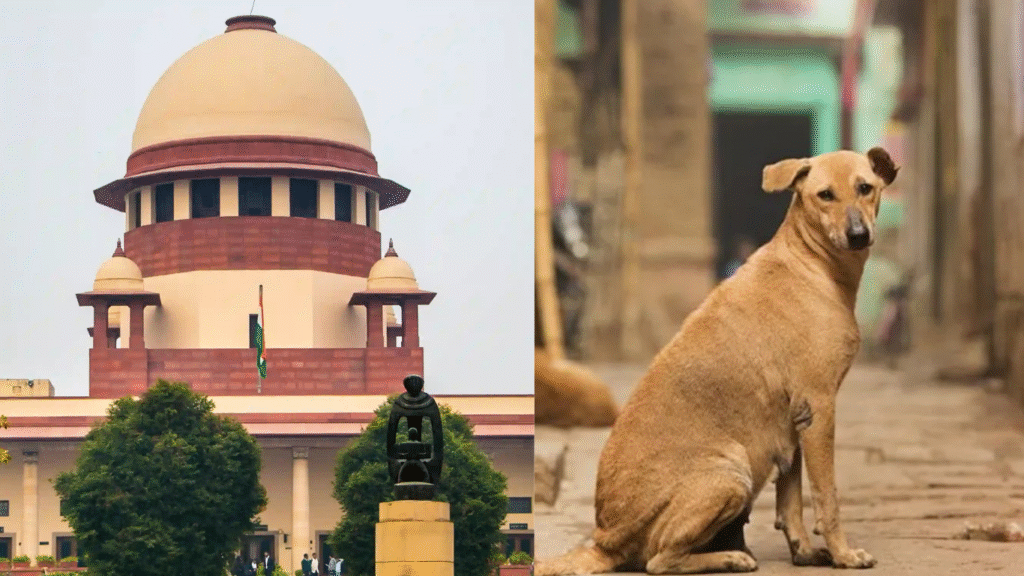New Delhi: In a landmark move to address the escalating threat of stray dog attacks and rabies outbreaks, the Supreme Court of India has issued stringent directives aimed at controlling the stray dog population in the National Capital Region (NCR). This decision comes in response to alarming reports of dog bites, particularly affecting children and infants, highlighting the urgent need for public safety measures. With India bearing the brunt of global rabies deaths, the court’s orders emphasize immediate action, including the creation of dedicated shelters, sterilization programs, and strict enforcement against obstructions.

The Supreme Court’s Suo Motu Intervention: Key Directions to Curb Stray Dog Threats
The Supreme Court, acting on its own initiative in a suo motu case triggered by disturbing media reports of stray dog attacks on children, has outlined a series of robust measures to eliminate the stray dog menace in Delhi and surrounding areas like Noida, Gurugram, and Ghaziabad. On August 11, 2025, a bench comprising Justices J.B. Pardiwala and R. Mahadevan emphasized that public spaces must remain safe and fear-free, especially for vulnerable groups such as infants and young children who should not fall prey to rabies.
Central to the court’s orders is the immediate capture of stray dogs from all localities, with a focus on high-risk areas in the city and its outskirts. Authorities, including the National Capital Territory (NCT) of Delhi, Municipal Corporation of Delhi (MCD), New Delhi Municipal Council (NDMC), and administrations in Noida, Gurugram, and Ghaziabad, are mandated to pick up strays without delay. Once captured, these dogs must be detained in newly established dog shelters or pounds and never released back into public spaces. The bench warned that any release would render the exercise futile and could invite stern action from the court.
To facilitate this, the court has directed the creation of sufficient dog shelters within six to eight weeks, initially capable of housing around 5,000 stray dogs. These facilities must be equipped with adequate personnel for sterilization and immunization, CCTV surveillance to prevent unauthorized releases, and meticulous daily records of captured animals. The court stressed that the shelters should expand progressively to accommodate more dogs over time.
In addition, a dedicated force may be formed if necessary to ensure efficient pick-up operations. A helpline must be established for reporting dog bite incidents, with authorities required to respond within four hours by capturing the offending dog. Victims must receive prompt assistance for treatment, including access to anti-rabies vaccines (ARV) and rabies immunoglobulin (RIG). The court has also ordered the compilation and submission of detailed data on vaccine availability, stock levels, and monthly patient reports.
The bench took a firm stance against resistance, stating that any individual or organization obstructing the pick-up process would face contempt proceedings. Justice Pardiwala invoked a cinematic analogy from the Western film “The Good, The Bad and The Ugly” to underscore the need for action over discussion: “If you have to shoot a man, shoot and don’t talk… So, no talk. It is time to act and now.” He further questioned animal rights activists by asking if they could restore children lost to rabid dogs to their parents, balancing compassion for animals with human safety.
The court described the situation as “extremely grim,” noting that the directives serve the larger public interest to inspire confidence among residents, young and old, to move freely without fear. In a lighter remark, Justice Pardiwala hoped the orders wouldn’t lead to stray dogs suddenly becoming pets overnight.
Delhi Government’s Response: Welcoming the Order with a Structured Plan
The Delhi Government has wholeheartedly welcomed the Supreme Court’s directives, viewing them as a critical step to tackle the stray dog crisis that has reached a boiling point in the national capital. Chief Minister Rekha Gupta highlighted the order’s significance, assuring citizens that her administration will implement a comprehensive, well-structured plan to provide much-needed relief. She emphasized that the government never shies away from public welfare projects and that dogs in shelters would be treated as pets.
Delhi Mayor Raja Iqbal Singh echoed this support, announcing that the Municipal Corporation of Delhi (MCD) will execute the removal in a phased manner. The first phase targets rabies-infected or bite-prone dogs, with subsequent phases addressing the broader stray population. MCD currently operates 20 shelter homes, and plans include collaborating with NGOs, launching a helpline, and holding meetings with NCR agencies to create dog-free zones and enhance sterilization efforts.
The Scale of the Stray Dog Problem in India and NCR
India grapples with a massive stray dog population, estimated at nearly 1.5 crore based on the 2019 livestock census. Delhi alone, according to a 2012 census, had around 60,000 strays, a figure now believed to be closer to 1 million. These dogs roam streets and colonies, often forming packs that pose risks to children and the elderly, with attacks frequently making headlines.
Rabies remains a major concern, as dogs are the primary source of this vaccine-preventable, zoonotic viral disease. India accounts for 36% of the world’s rabies deaths, with dog bites responsible for 96% of transmissions, per the National Centre for Disease Control. In Delhi, between January and June 2025, there were 35,198 animal bite incidents and 49 rabies cases, underscoring the urgency.
The suo motu case was initiated on July 28, 2025, following a newspaper report about the rabies-related death of a six-year-old girl, which the court deemed “very disturbing and alarming.”
Legal and Judicial Framework Governing Stray Dogs
Several laws and judicial precedents shape stray dog management in India. The Animal Birth Control Rules, 2023, under the Prevention of Cruelty to Animals Act, 1960, promote population control through sterilization and vaccination to curb rabies. The Supreme Court in the 2014 Jallikattu case extended Article 21’s right to life and liberty to animals. In the People for Elimination of Stray Trouble v. Animal Welfare Board of India case, the court suspended the killing of street dogs, including nuisances.
Constitutionally, Article 243W empowers municipalities to control stray populations, while Article 51A(g) imposes a fundamental duty on citizens to show compassion for living creatures, supporting the right to feed strays contrary to common misconceptions.
Other protections include the Environment (Protection) Act, 1986, and Wildlife (Protection) Act, 1972, which safeguard against cruelty. The Animal Birth Control (Dogs) Rules, 2001, prohibit relocating or removing dogs from their territories. A 2009 Supreme Court order stayed culling or dislocation nationwide.
Local bodies bear responsibility for stray management, including shelters, sterilization, and vaccination programs. The Delhi High Court has previously directed guidelines for dog rehabilitation and affirmed that dogs should be treated with dignity.
Challenges in Implementing Stray Dog Control Measures
Despite these frameworks, controlling stray dogs faces significant hurdles. Infrastructure deficits, such as insufficient animal birth control centers and trained veterinary professionals, hamper efforts. Shortages of ARV and RIG in primary care centers exacerbate the issue.
Ethical dilemmas arise from conflicts between animal welfare and human safety, with stray dog control becoming a divisive civic issue. While some residents view strays as a menace, others treat them as family, providing food, water, and care through community feeders.
Implementing the court’s orders poses logistical and financial challenges. Constructing shelters for potentially millions of dogs requires land acquisition, building, staffing, and operations, likely costing millions. Funding could come from government allocations, private donations, corporate sponsorships, and collaborations with animal welfare organizations.
The court acknowledged the progressive nature of the exercise, urging increases in shelter capacity over time.
Reactions from Stakeholders and Broader Implications
The orders have sparked controversy. Animal protection groups, including the Federation of Indian Animal Protection Organisations and PETA India, labeled them “impractical and inhumane.” Bharati Ramachandran advocated for large-scale sterilization, vaccination, and awareness campaigns, while Mini Aravindan highlighted the infeasibility of sheltering hundreds of thousands of dogs and the enormous costs.
Protests erupted, with dog lovers demonstrating near Hanuman Mandir at Connaught Place on August 12, 2025, and several activists detained at India Gate. Celebrities like Vir Das urged adoption of indie dogs, and political figures including Rahul, Priyanka, Maneka, and Varun Gandhi showed rare unity in opposing the order.
Solicitor General Tushar Mehta supported the court’s stance on behalf of the government.
Related developments include the Supreme Court cracking down on leftover food disposal in court premises to avoid attracting strays. Broader discussions reference global contexts, like trackless trams in Pakistan or U.S. trade issues, but the focus remains on India’s stray crisis.
Conclusion: Toward a Balanced Approach
The Supreme Court’s directives mark a pivotal shift in addressing the stray dog menace, prioritizing public safety while mandating humane treatment through sterilization and immunization. A balanced strategy could involve intensive sterilization, vaccination, dedicated shelters, and redefining human-dog relationships, such as promoting service dogs.
As Delhi-NCR authorities gear up for implementation, the success of these measures will depend on coordinated efforts, adequate resources, and navigating ethical tensions. This ruling not only aims to reduce rabies risks but also to foster safer urban environments, ensuring no compromise on the well-being of citizens or animals.
FAQs
1. What did the Supreme Court order regarding stray dogs in Delhi-NCR on August 11, 2025?
The Supreme Court directed authorities in Delhi, Noida, Gurugram, and Ghaziabad to immediately capture stray dogs from all localities, particularly vulnerable ones, and house them in dedicated shelters. These dogs must be sterilized, vaccinated, and never released back into public spaces. The court mandated the creation of shelters to accommodate around 5,000 dogs within six to eight weeks, equipped with CCTV surveillance, sufficient staff, and detailed records. A helpline for reporting dog bites and swift action within four hours were also ordered, with contempt action threatened against anyone obstructing the process.
2. Why did the Supreme Court issue these directives?
The court acted suo motu on July 28, 2025, following a newspaper report about a six-year-old girl’s death due to rabies from a stray dog attack, described as “very disturbing and alarming.” The rising incidents of dog bites, especially affecting children and infants, and India’s high rabies death rate (36% of global cases) prompted the court to prioritize public safety, ensuring fear-free movement in public spaces.
3. How is the Delhi government planning to implement the Supreme Court’s order?
Delhi Chief Minister Rekha Gupta and Mayor Raja Iqbal Singh welcomed the order, promising a comprehensive, phased plan. The Municipal Corporation of Delhi (MCD) will initially target rabies-infected or bite-prone dogs, utilizing 20 existing shelter homes and collaborating with NGOs. A helpline will be launched, and meetings with NCR agencies are planned to create dog-free zones and scale up sterilization efforts, ensuring dogs in shelters are treated humanely as pets.
4. What are the challenges in controlling the stray dog population in Delhi-NCR?
Challenges include inadequate infrastructure, such as limited animal birth control centers and a shortage of trained veterinary professionals. There’s also a low availability of anti-rabies vaccines (ARV) and rabies immunoglobulin (RIG) in primary care centers. Ethical conflicts between animal welfare and public safety, along with the high cost of building and operating shelters for potentially millions of dogs, pose significant hurdles. The estimated stray dog population in Delhi alone is around 1 million.
5. How have animal rights groups and the public reacted to the Supreme Court’s ruling?
Animal protection groups, like the Federation of Indian Animal Protection Organisations and PETA India, criticized the order as “impractical and inhumane,” advocating for sterilization, vaccination, and awareness campaigns instead. Protests occurred, with activists detained at India Gate and demonstrations near Hanuman Mandir in Connaught Place on August 12, 2025. Public figures like Vir Das and Gandhi family members opposed the order, while some residents supported it due to safety concerns, highlighting the divisive nature of the issue.

